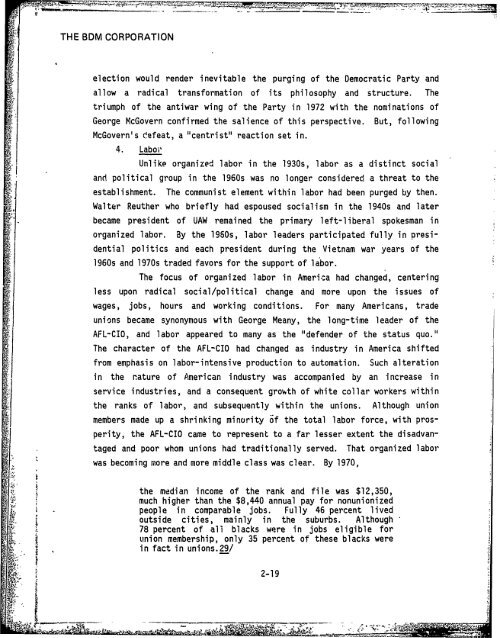policy - The Black Vault
policy - The Black Vault
policy - The Black Vault
Create successful ePaper yourself
Turn your PDF publications into a flip-book with our unique Google optimized e-Paper software.
THE BDM CORPORATION<br />
election would render inevitable the purging of the Democratic Party and<br />
allow a radical transformation of its philosophy and structure. <strong>The</strong><br />
triumph of the antiwar wing of the Party in 1972 with the nominations of<br />
George McGovern confirmed the salience of this perspective.<br />
McGovern's d.efeat, a "centrist" reaction set in.<br />
4. Laboi"<br />
Unlike organized labor in the 1930s,<br />
But, following<br />
labor as a distinct social<br />
and political group in the 1960s was no longer considered a threat to the<br />
establishment.<br />
<strong>The</strong> communist element within labor had been purged by then.<br />
Walter Reuther who briefly had espoused socialism in the 1940s and later<br />
became president of UAW remained the primary left-liberal spokesman in<br />
organized labor. By the 1960s, labor leaders participated fully in presidential<br />
politics and each president during the Vietnam war years of the<br />
1960s and 1970s traded favors for the support of labor.<br />
<strong>The</strong> focus of organized labor in America had changed, centering<br />
less upon radical social/political change and more upon the issues of<br />
wages, jobs, hours and working conditions. For many Americans, trade<br />
unions became synonymous with George Meany,<br />
the long-time leader of the<br />
AFL-CIO, and labor appeared to many as the "defender of the status quo."<br />
<strong>The</strong> character of the AFL-CIO had changed as industry in America shifted<br />
from emphasis on labor-intensive production to automation.<br />
Such alteration<br />
in the rature of American industry was accompanied by an increase in<br />
service industries, and a consequent growth of white collar workers within<br />
the ranks of labor, and subsequently within the unions.<br />
Although union<br />
members made up a shrinking minority 6f the total labor force, with prosperity,<br />
the AFL-CIO came to represent to a far lesser extent the disadvantaged<br />
and poor whom unions had traditionally served.<br />
was becoming more and more middle class was clear. By 1970,<br />
That organized labor<br />
#! •the median income of the rank and file was $12,350,<br />
much higher than the $8,440 annual pay for nonunionized<br />
p eople in comparable jobs. Fully 46 percent lived<br />
outside cities, mainly in the suburbs. Although<br />
78 percent of all blacks were in jobs eligible for<br />
union membership, only 35 percent of these blacks were<br />
in fact in unions.29/<br />
Z!<br />
R -7i<br />
2-19
















